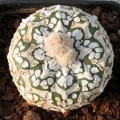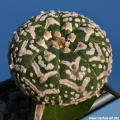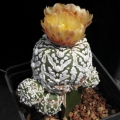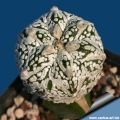Donate now to support the LLIFLE projects.
Your support is critical to our success.
Your support is critical to our success.
Accepted Scientific Name: Astrophytum asterias cv. Superkabuto V type

Astrophytum asterias cv. Superkabuto Fly's-wings type (Astrophytum asterias cv. Superkabuto V type) Photo by: Valentino Vallicelli
Contrary to the normal Astrophytum Superkabuto, that has only a mosaic of extensive ± rounded white dots the “Zebra type” differs for the diverse pattern that form distinct v-shaped lines resembling the shape of fly's wings. This particular form is also called "V-type", “Fly's wings type” or “Tiger” by Thai growers. The white V-markings and striped bands are not seen in most of the normal 'Super Kabuto' seedlings, and will change and emphasize with age.
Contrary to the normal Astrophytum Superkabuto, that has only a mosaic of extensive ± rounded white dots the “Zebra type” differs for the diverse pattern that form distinct v-shaped lines resembling the shape of fly's wings. This particular form is also called "V-type", “Fly's wings type” or “Tiger” by Thai growers. The white V-markings and striped bands are not seen in most of the normal 'Super Kabuto' seedlings, and will change and emphasize with age.
Synonyms:
See all synonyms of Astrophytum asterias
back
Accepted name in llifle Database:Astrophytum asterias (Zucc.) Lem.
Cactées 50. 1868
Synonymy: 18
- Astrophytum asterias (Zucc.) Lem.
- Astrophytum asterias f. aurea hort.
- Astrophytum asterias f. cristatum hort.
- Astrophytum asterias var. magnipunctatum Frič
- Astrophytum asterias var. multipunctatum Frič
- Astrophytum asterias var. nudicarpa Frič
- Astrophytum asterias var. nudum Y.Itô
- Astrophytum asterias var. nudum f. aurea hort.
- Astrophytum asterias var. nudum f. cristata hort.
- Astrophytum asterias var. nudum f. rubra hort.
- Astrophytum asterias f. proliferum hort.
- Astrophytum asterias var. pubescente Y.Itô
- Astrophytum asterias var. roseiflorum Frič
- Astrophytum asterias var. seminuda Frič
- Astrophytum asterias var. striatipetalum Y.Okomura & Y.Itô
- Astrophytum asterias cv. Hanazono Star Type
- Astrophytum asterias cv. Akabana
- Astrophytum asterias cv. Alpus
- Astrophytum asterias cv. Ekubo Kabuto
- Astrophytum asterias cv. Elephant Skin
- Astrophytum asterias cv. Feather Flower
- Astrophytum asterias cv. Fukuryiu
- Astrophytum asterias cv. Gelbe Bluete
- Astrophytum asterias cv. Godzilla
- Astrophytum asterias cv. Gokuu-kabuto
- Astrophytum asterias cv. Golden kabuto
- Astrophytum asterias cv. Goryo Kabuto (Five Ribs)
- Astrophytum asterias cv. Goryo Kabuto (Five Ribs) + Ruri
- Astrophytum asterias cv. Goryo Kabuto (Five Ribs) + Ruri + Fukuryiu + Ooibo
- Astrophytum asterias cv. Hakuun
- Astrophytum asterias cv. Hakuun forma prolifera
- Astrophytum asterias cv. Hanaizumi
- Astrophytum asterias cv. Hanazono
- Astrophytum asterias cv. Ibosaki Kabuto
- Astrophytum asterias cv. Ikaryoko
- Astrophytum asterias cv. Kigan Kabuto
- Astrophytum asterias cv. Kikko
- Astrophytum asterias cv. Kikko Lizard Skin
- Astrophytum asterias cv. Kikko Nudum
- Astrophytum asterias cv. Kikko Nudum f. aurea
- Astrophytum asterias cv. Kikko Nudum f. cristata
- Astrophytum asterias cv. Kikko Nudum violet
- Astrophytum asterias cv. Kiku Kabuto
- Astrophytum asterias cv. Kofuki Kabuto
- Astrophytum asterias cv. Koo-yo
- Astrophytum asterias cv. Mamma Kikko
- Astrophytum asterias cv. Mirakuru Kabuto
- Astrophytum asterias cv. Mottles
- Astrophytum asterias cv. muscle
- Astrophytum asterias cv. muscle cristatum
- Astrophytum asterias cv. Musha Kabuto
- Astrophytum asterias cv. Nisiki (orange)
- Astrophytum asterias cv. Nisiki (yellow)
- Astrophytum asterias cv. Nohakuten Kabuto
- Astrophytum asterias cv. Ohkan Kabuto
- Astrophytum asterias cv. Ooibo + Ruri (nudum) Kabuto
- Astrophytum asterias cv. Ooibo Kabuto
- Astrophytum asterias cv. Rasen Kabuto
- Astrophytum asterias cv. Rensei
- Astrophytum asterias cv. Ruri Kabuto Akabana
- Astrophytum asterias cv. Ruri Kabuto Nisiki (Orange-Red)
- Astrophytum asterias cv. Ruri Kabuto Nisiki (Yellow)
- Astrophytum asterias cv. Sakata Kabuto
- Astrophytum asterias cv. Showa
- Astrophytum asterias cv. Showa Red
- Astrophytum asterias cv. Shinshowa Akabana
- Astrophytum asterias cv. Shinshowa Red
- Astrophytum asterias cv. Syowa Kabuto
- Astrophytum asterias cv. Star Type
- Astrophytum asterias cv. Super Hanazono
- Astrophytum asterias cv. Superkabuto
- Astrophytum asterias cv. Super Kabuto
- Astrophytum asterias cv. Superkabuto + Ooibo
- Astrophytum asterias cv. Superkabuto + Rensei (Line Areoles)
- Astrophytum asterias cv. Superkabuto f. cristata
- Astrophytum asterias cv. Superkabuto f. monstruosa
- Astrophytum asterias cv. Superkabuto f. prolifera
- Astrophytum asterias cv. Superkabuto f. prolifera cristata
- Astrophytum asterias cv. Superkabuto Five Ribs
- Astrophytum asterias cv. Superkabuto Snow Type
- Astrophytum asterias cv. Superkabuto Snow Type f. cristata
- Astrophytum asterias cv. Superkabuto Snow Type f. monstruosa
- Astrophytum asterias cv. Superkabuto Star Type
- Astrophytum asterias cv. Superkabuto Star Type + Snow type
- Astrophytum asterias cv. Superkabuto Star Type + V Type
- Astrophytum asterias cv. Superkabuto Sutadorimu
- Astrophytum asterias cv. Superkabuto V type
- Astrophytum asterias cv. Superkabuto Fly's-wings type
- Astrophytum asterias cv. Superkabuto Tiger
- Astrophytum asterias cv. Superkabuto Zebra type
- Astrophytum asterias cv. Superkabuto V type f. cristatum
- Astrophytum asterias cv. Superkabuto Yellow Dots Type
- Astrophytum asterias cv. Taryo Kabuto
- Astrophytum asterias cv. Thirteen ribs
- Astrophytum asterias cv. Wakareryu
back

Astrophytum asterias cv. Superkabuto Fly's-wings type (Astrophytum asterias cv. Superkabuto V type) Photo by: Valentino Vallicelli

Bangkok. TAC 04�32018 (Astrophytum asterias cv. Superkabuto V type) Photo by: Flavio Agrosi

Astrophytum asterias cv. Superkabuto Fly's-wings type (Astrophytum asterias cv. Superkabuto V type) Photo by: Valentino Vallicelli

Astrophytum asterias cv. Superkabuto Fly's-wings type (Astrophytum asterias cv. Superkabuto V type) Photo by: Valentino Vallicelli

Astrophytum asterias cv. Superkabuto Fly's-wings type (Astrophytum asterias cv. Superkabuto V type) Photo by: Cactus Art

Bangkok. TAC 04�32018 (Astrophytum asterias cv. Superkabuto V type) Photo by: Flavio Agrosi

Astrophytum asterias cv. Superkabuto Fly's-wings type (Astrophytum asterias cv. Superkabuto V type) Photo by: Cactus Art

Astrophytum asterias cv. Superkabuto Fly's-wings type (Astrophytum asterias cv. Superkabuto V type) Photo by: Prof. Ilham Alakbarov
Your Photos
| Your Actions | |
|---|---|
| Back to Astrophytum index | |
| Back to Cactaceae index | |
 |
Back to Cacti Encyclopedia index |














